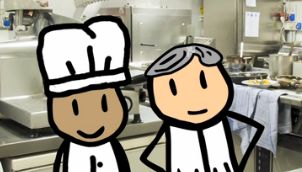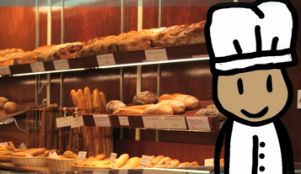Locke's Goal-Setting Theory: Using Goals to Advance Motivation
After you watch the video and know the material, click HERE for the quiz.
Locke's Goal-Setting Theory uses clear and challenging goals to advance employee motivation in the workplace. Goals that are well defined and challenging to attain are more likely to be met because they hold intrinsic and extrinsic value to the employee.
Locke's Goal-Setting Theory
Why does it feel so good to accomplish a really challenging goal? The answer is simple! Locke's Goal-Setting Theory says that when challenging goals are set for an employee, the proper tools are provided to accomplish those goals and positive feedback is given, the employee feels satisfaction with the performance and the reward. This makes the employee want to strive to accomplish an even more challenging goal.
 |
Chef Alfredo had a dream of decorating cakes for the rich and famous. As he sautéed and fricasseed at House of Pasta, his mind would drift to far away places like Hollywood and Paris, where he would present the most beautiful cakes and pastries to the most discriminating palates. One day, Alfredo's boss Romero frantically called a team meeting. A few French dignitaries had made a reservation for a private party at the restaurant. Romero put Alfredo on cakes and pastries. His dream came true!
Employee Motivation
Employee motivation in goal setting is actually very simple. You just need to:
- Set clear goals
- Provide appropriate feedback
Romero got busy on the menu. Chef Alfredo was tasked to make a three-tier chocolate cake, several types of cookies and the artisan breads for the evening. Not knowing much about baking, Alfredo relied heavily on Romero to give direction. Romero told Alfredo to try his best and do a good job. This left Alfredo flat. He did not know what it meant to do his best. He thought long and hard about where to begin. What Romero did wrong was to give Alfredo vague information about the level of performance expected.
 |
In goal setting, goals should:
- Have clarity
- Pose a challenge
- Gain employee commitment
- Provide management feedback
- Involve task complexity
Alfredo began asking questions. He asked Romero about the size of the cake, the flavor of the cookies and the variety of breads he needed to create. Romero and Alfredo sat down together and made a list of things to be done. The cake had to be three tiers and serve 100 people, 300 dozen cookies in several flavors needed to be baked and four types of breads needed to be baked. Now it was a bit clearer, and it certainly was a challenge. Alfredo had just one day to accomplish all of the tasks on the list, and they had to be done to perfection.
 |
Goal-Setting Model
A closer look at the model will prove that specific and difficult goals are better than vague and easy goals. It all starts with the goal core, which defines goals as specific and difficult in the areas of performance, learning or proximal (short-term) achievements. Next, we visit performance, and this refers to increased productivity. Satisfaction with performance and reward comes from completing a difficult task. And this satisfaction creates a willingness to commit to a new, more difficult task.
As tasks are completed, moderators like goal commitment, feedback and task complexity are evaluated:
- Goal commitment occurs when goals are made public and are self-set, and employees view the goal as important, such as learning a new task to increase one's knowledge base or performing a new task to avoid negative feedback.
- Feedback must happen in a timely way and help employees track progress.
- Task complexity must be high.
When all of the moderators work together, motivation is high.
Let's see how Alfredo is doing in the kitchen. Alfredo is ramped up with motivation. He knows exactly what needs to be done, the timeline is set and the ingredients and equipment are available to him. Alfredo mixes and pours the batter, bakes and decorates the layers of cake, rolls and cuts the cookies and kneads and proofs the bread dough. With every bead of sweat on his forehead, Alfredo is completing all of his tasks, albeit not with ease.
 |
 |
Lesson Summary
Locke's Goal-Setting Theory says that when challenging goals are set for an employee, the proper tools are provided to accomplish those goals and positive feedback is given, the employee feels satisfaction with the performance and the reward. This feeling of satisfaction motivates an employee to set and accomplish even more challenging goals. Challenging goals can be accomplished when clear goals are set and timely feedback is provided.
While setting goals, there are a few things to keep in mind. Goals should:
- Have clarity
- Pose a challenge
- Gain employee commitment
- Provide management feedback
- Involve task complexity
The goal-setting model begins with the goal core, or setting specific and challenging goals. Next, performance is determined in terms of productivity. As goals are accomplished, positive feedback and reward create a sense of employee satisfaction with the goal and create a desire to set and accomplish more challenging goals. Moderators like ability, goal commitment, feedback and task complexity are important for goal accomplishment because when all are met, employee motivation is high.